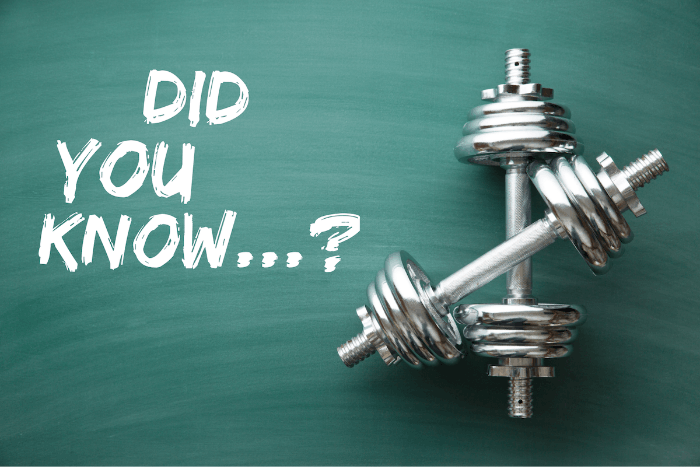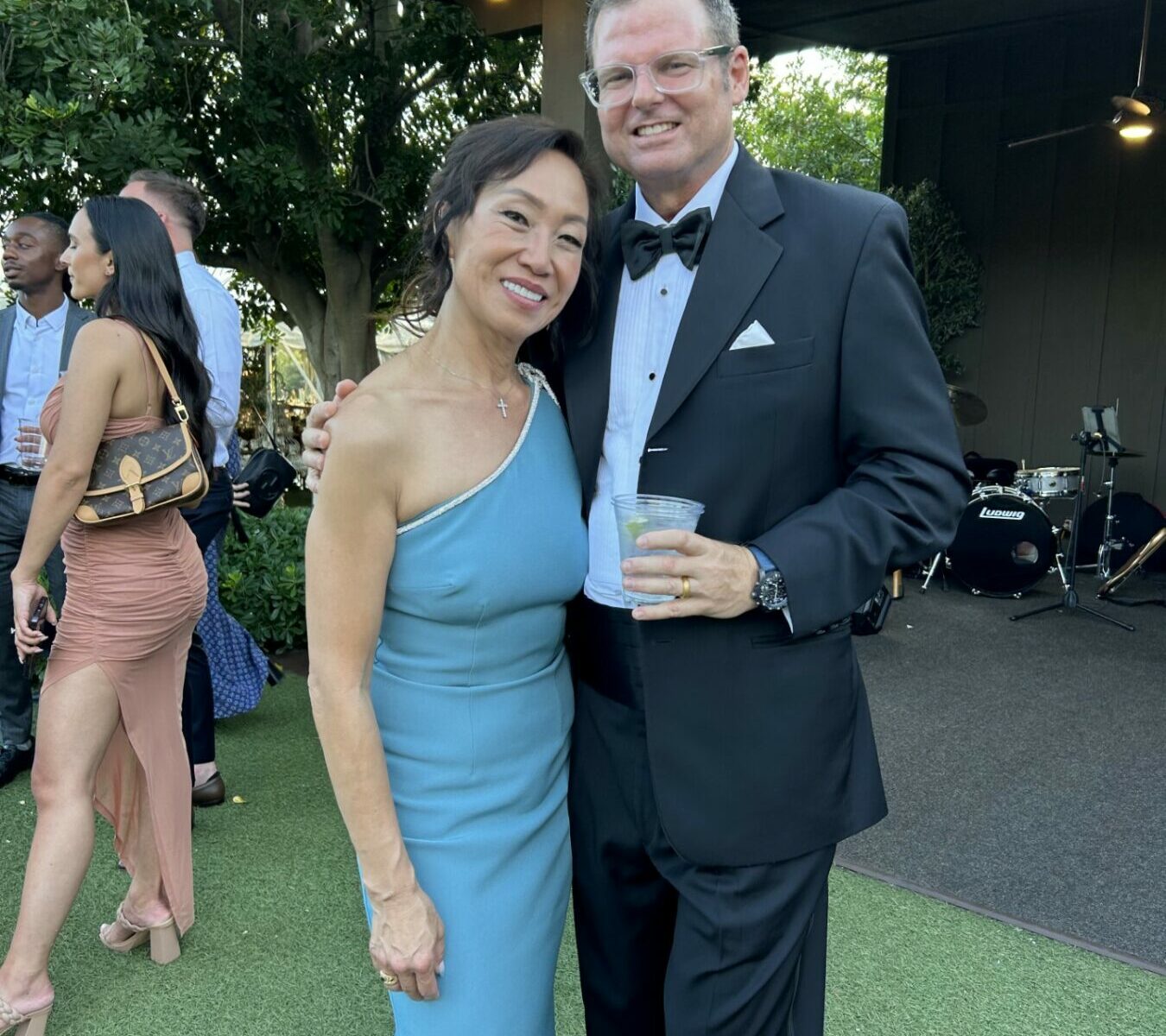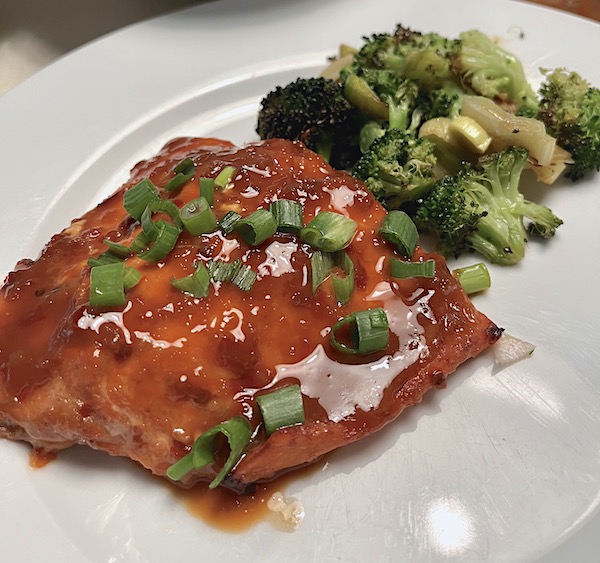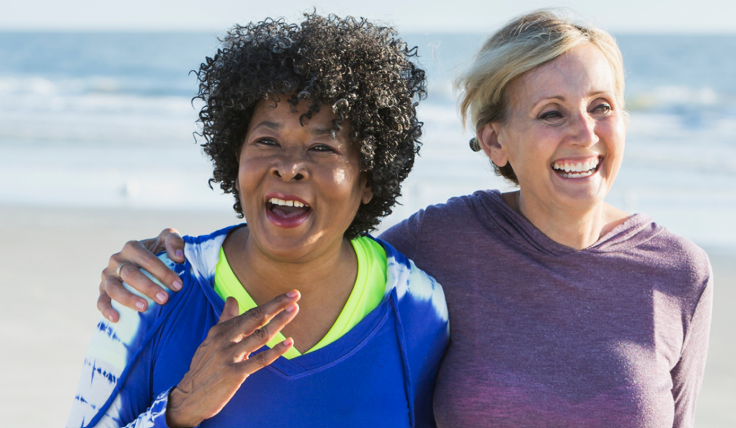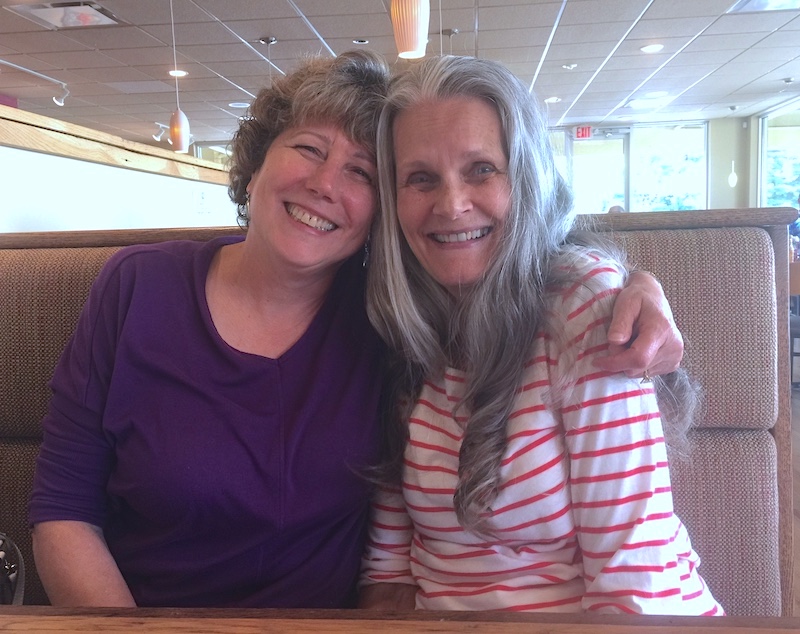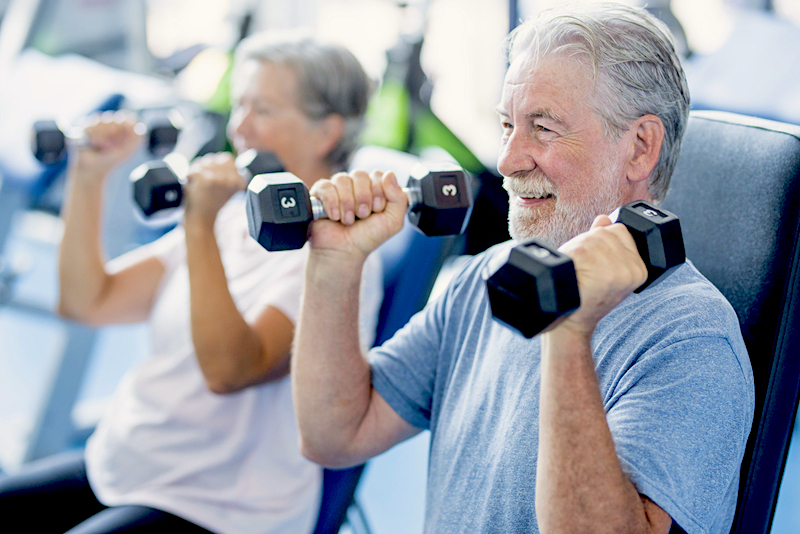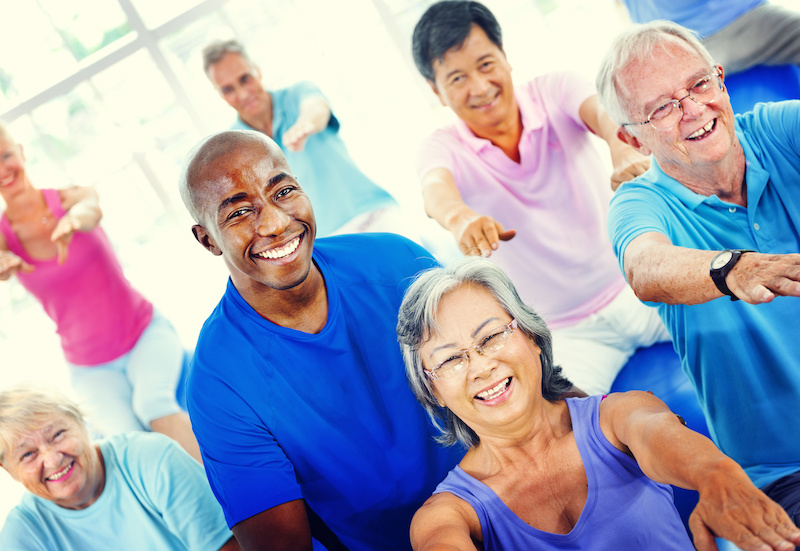For Dr. Bruce Lockhart, it was finally back surgery that got him committed to regular exercise near retirement a decade ago. Over the years, he had treated enough patients with chronic back pain to know that he didn’t want to become one after the procedure. So he found the right trainer at the right gym and has been enjoying it for 10 years, pain free. “I like not looking like I’m 77 years old,” says Bruce, who enjoys hiking, working in his large garden, and running obstacle-course races — in addition to three-times-a-week small group training at the gym. “You can very quickly become a couch potato at my age,” he says. “It’s pretty easy. But I really enjoy going to the gym. It’s just become part of my life.” Exercise Before and After Surgery Bruce is a great example of how fitness helps us overcome common physical challenges that can affect us later in life – like his back pain, or surgery for a joint replacement that so many people need. Even healthy ones. Mature adults who exercise regularly are less likely to suffer a disability – and they are more likely to recover faster, according to one study published in the Annals of Internal Medicine. Researchers said the active participants in the study had been “built up” by exercise and had become “more resilient” than sedentary peers And the National Institutes for Health concludes that exercise before and after surgery is important for ensuring its success in older people. Trainer Shebah Carfagna believes she benefitted from her physical fitness when she needed hip replacement surgery a couple of years ago in her 60s – in “prehab” as well as rehab. “You have to take what life gives you and make it work and adjust,” Shebah says. “It’s important for the body to continue to move. You just can’t stop become something happens. You have to keep going.” Find Something You Like For Bruce, his life as a physician and his own experiences in the gym have taught him that nothing promotes healthy longevity like exercise. “If you don’t stay fit, sooner or later, things are going to start to go downhill,” he says. “It’s so important if you care about how long you spend on this earth.” Bruce recommends finding a gym or studio you like – where you feel comfortable and welcome. He enjoys working with his “inspiring” trainer, and in a small group whose members keep each other accountable. But it’s not essential for everyone. His top piece of advice? “Find something you enjoy doing,” he says. “It’s not going to become drudgery if you enjoy it.” >We couldn’t agree more. Let’s get you moving today!
20 Fun Facts & Hacks about Fitness over 50
|
|
We’re sharing a ton of short, useful tidbits about fitness over 50 – fun facts and hacks to make your life easier.The goal? To show you the overwhelming evidence: If you want to stay healthy, strong and independent, you simply must keep moving.
- GET OUT: Just being outdoors, especially in green spaces, quickly improves our health and happiness. — The International Journal of Environmental Health Research
- HEART STRONG: Weightlifting has a greater effect than running, walking or cycling on lowering the risk of heart disease, according to research in the British Telegraph.
- HIIT HAPPENS: High-Intensity Interval Training (HIIT) is good for everyone “and has even bigger benefits for older adults.” — The Mayo Clinic
- A GRAND IDEA: “I want primary care physicians to prescribe not only antidepressants but also prescribe a dose of exercise for the treatment of depression.” — Dr. Madhukar Trivedi
- FEEL BETTER: Exercise alleviates aches and pains, including low back pain, the second most common cause of disability in the United States.
- PROTECT YOURSELF: The Alzheimer’s Association says regular cardiovascular exercise can help reduce the risk of getting the disease.
- BURN FAT: Resistance training burns fat. Think it’s all about cardio? Wrong.
- YOUR BUTT: The gluteus maximus is the largest muscle in the body.
- MIRACLE DRUG: Exercise is good for your bones, muscles, balance, heart, mental health and sleep.
- SMILE: Maintaining a positive outlook adds years of healthy life.
- WE’RE HOT: Fitness training for mature adults (over 50) has ranked near the top of global fitness trends the last few years.
- AT 100: “I do as I feel, and I like to stay active and be around people. I still want to keep moving. If I sat down, I think I’d just give up.” — Toni Stahl of Kentucky, who worked out regularly at age 100.
- THINK: Jimmy Hatcher of Georgia prizes the meditative aspect of exercise: “It slows you down and requires you to focus on the moment, not what you need to do later.”
- HAVE FUN: “Exercising makes me feel good when I’m done, and even when I’m doing it.” — Sue Heaton of Chicago
- SPORTS EDGE: Gym workouts give you a competitive edge in golf, tennis, running and other sports.
- EAT THE RAINBOW: Get five servings of fruit and vegetables a day; it helps to keep a frozen stash.
- STAY HYDRATED: Don’t wait till you’re thirsty to drink up.
- REMEMBER: You’re just one workout away from a good mood.
- OLIVER WENDELL HOLMES: “We don’t quit playing because we grow older; we grow older because we quit playing.”
- JACK LALANNE: “People don’t die of old age. They die of inactivity.”
What are some of your favorite morsels about living your best life? Let’s keep this going! We’ll share more later.
 |
Exercise Fights Depression as Well as Therapy, Study Finds
Millions of people struggle with depression, and lots of those take medicine or talk to a therapist for treatment.But did you know physical exercise is just as effective, according to research?“Exercise is an effective treatment for depression, with walking or jogging, yoga, and strength training more effective than other exercises, particularly when intense,” the authors write in The BMJ. “These forms of exercise could be considered alongside psychotherapy and antidepressants as core treatments for depression.“Exercise may be an effective complement or alternative to drugs and psychotherapy.”Depression is a leading cause of disability around the world, the authors write. It lowers life satisfaction more than debt, divorce and diabetes, and worsens comorbidities such as heart disease, anxiety and cancer.The researchers analyzed data from 218 studies on depression and exercise involving some 14,000 people.Previous studies have come to similar conclusions: Exercise is effective against depression. Experts say it should be considered in treatment, along with therapy and anti-depressants.Don’t take your mental health for granted. If you’re having issues, talk to your doctor or counselor. Take this study as further proof of the powerful mind-body connection – and that physical exercise is always good for whatever ails you.And remember to choose exercise that you enjoy. If it’s not fun, you’re less likely to stick with it and gain the most benefits. We are here to help.
Meet our Inspirations of the Week: Scott & Gloria
To celebrate the month of love we have one of our many couples here at FCF…
Scott & Gloria and their unique story…
Today if you were to pass them on the street you would notice a fit, healthy couple and when you find out they regularly exercise even think, ‘well of course they “look” like fitness people’. However, their story shares a different tale of why they regularly train with us at FCF.
We absolutely love both of their positive attitudes, even when it’s a tough day. They come in, do the best they can that day, and leave feeling 10x better than when they walked in. Where many people who see obstacles, they see a reason to a maintain a healthy training program, so that they not only benefit today, but their future self in 20 or 30 years. These rockstars have maintained dedicated to their fitness program, have great work ethic, have persevered through various health challenges, and hit so many personal milestones, which makes them our inspirations of the week!
Here’s their why…
|
|
Almost 7 years ago, Scott woke up one morning with excruciating pain in his neck. This eventually led to a major neck surgery, some nice hardware and a change in Scott’s lifestyle. Post surgery the things he loved, like surfing, was off the table due to the uncertainty of permanently damaging his neck. His exercise routine of boxing in the garage and road biking all became a challenge or not an option. Life took a turn and now he had to figure out how to regain his strength and find new safe activities to maintain a healthy lifestyle.
Two months post-surgery, his friend and former law partner told him about Full Circle Fitness and since physical therapy hadn’t helped manage his pain he reached out for help from Rosa. After meeting Rosa and putting together a plan that started with some mobility work and pilates, he was sold and became a dedicated member. Gloria says, “Rosa’s knowledge, good nature, and empathy for his situation helped him immeasurably.”
Over the last 6 years at Full Circle Fitness Scott’s training program progressed from mobility and pilates, to strength training, and now he participates in small group training sessions and some yoga to help manage his pain and alignment. He can’t say he loves it all the time, but the routine provides relief and that’s what’s most important.
He will tell you, “There are days I wake up with incredible pain, but after a session with Rosa, I am able to sit at a desk and work, as well as to be able to manage some outdoor activities that I enjoy. What a miracle and a blessing. I have been working with Rosa twice a week for almost 6 years.”
After 2 years of training, he was even confident enough to try surfing again when the conditions are right, has returned to road biking and even participated in a few 50 mile and 100 km races. That’s the truly important stuff here. His passions that he thought were gone after surgery, are back! To say I am proud as his coach is an understatement.
Although there are still some days where there is more pain, after a training session he always leaves feeling better and is able to take on the day!
As for Gloria, well….Her reason for starting a training program was completely different, but equally important.
Here’s her story…
” I absolutely abhor exercise.”
Scott said, ‘no come in and meet the folks at FCF. They’re great. I think you’ll like it.’
She’d heard that before from Scott; some trickery to try to get her to exercise!
You see… everyone has a journey and although they start at different times, for different reasons, and has different goals, the most important part is that they started and encourage each other.
They didn’t give up or stop when severe pain, migraines, surgeries, business travel or a variety of other stressors came up in life. They took a day, or two or even a week off then came back with a vengeance, they know their deeper why and Scott and Gloria had each other to keep each other accountable.
They had a mutual goal this past year as well…their son’s wedding!
They doubled down, cleaned up their nutrition a bit and attended their son’s wedding feeling confident, with enough energy, and enjoyed the special moment. That’s what matters!
If you’re ready to find out how to create a realistic and maintable fitness program, we would love to help. Just text or call us at 657-231-6207.
Talk soon,
Coach Rosa
‘Skip-Gen’ Trips and Other Travel Trends for 2024
Travel and grandchildren rank as top motivators for people over 50 to get in shape or stay in shape. Both those are combined now in one of the top 2024 travel trends for mature adults: the “skip-gen” trip, as in “skip a generation.” It’s when grandparents take grandchildren on a vacation without the parent in the middle. “I work hard to stay in good shape so I can enjoy my sports, my retirement – and my grandchildren,” says Sammye, who took her first grandchild, Mia, to Paris to celebrate graduation from high school. It’s something she’ll do for each grandchild, a special experience they can share alone together. “We covered a lot of ground on foot. We climbed a lot of stairs. And we had a blast,” says Sammye, who is in her 60s and enjoys gym workouts and competing in triathlons. “The next granddaughter wants to go to Rome. I’m ready!” Traveling of any kind requires strength, endurance and agility. And spending time with a teenager alone? Oh, yes. We’ll make sure you’re ready to make the most of your travel this year. Here are some other top trends for mature travelers. “Bleisure” TravelThis is a combination of “business” and “leisure” travel. If you’re still working and you want to mix and match, why not? It can be a great way to take advantage of an opportunity to spend time in a new or interesting location. Rest and RelaxationTravel industry experts say more people are looking to just go somewhere and chill – including focusing on getting plenty of good sleep, spa treatments, and exercise. Sounds like heaven to us! National ParksThe United States is blessed with a series of national parks worth exploring. Check out the promotions at the National Park Service website. From Alaska’s Denali to Florida’s Everglades, you won’t believe the richness that awaits. Bucket ListsThese are always popular with people later in life: Places to go and things to do before you kick the … well, you know. What’s on your list? What’s holding you back? If it’s your physical fitness level, don’t let that stop you! We’re here to get you wherever you want to go. AdventureWe know a man in his 50s who’s determined to ride his motorcycle on every continent. Could this finally be his year for Antarctica? Do you want to go white-water rafting? Heli-skiing? The possibilities are wild – and endless. Small GroupsGather friends or talk to a travel agency about joining small groups for travel. Just make sure you’re not the one stuck behind in your hotel room because you’re not able to make the most of the opportunities! The world remains your oyster for as long as you keep yourself motivated to enjoy it. We are here to help your travel dreams come true, whether they’re with grandkids in Europe, hiking at national parks, or checking off those “bucket list” items. Come see us today.
Exercise Can Help Fight Signs of Dementia, Study Says
You already know that exercise is good for your body. You might also know that it helps your brain, as well. But now, new research in the journal JAMA Neurology shows that living a healthy lifestyle protects the brain from cognitive decline even if it already shows signs of Alzheimer’s hallmarks or other brain pathologies that can occur long before dementia. Scientists said the study is “an important step” in understanding how people can change their lifestyle habits to lower their chances of getting Alzheimer’s or other types of dementia. In the research, they examined the brains of 586 people during autopsies, along with 24 years of data that was collected on how those people lived. “This study found that in older adults, a healthy lifestyle may provide a cognitive reserve to maintain cognitive abilities independently of common neuropathologies of dementia,” the scientists wrote. The authors report that five lifestyle factors (diet, physical activity, cognitive engagement, smoking, and alcohol consumption) “may operate through both prevention and resilience in that cognitive benefits were observed even for those who had neurodegenerative pathologies,” according to an editorial accompanying the research. More than 88% of a person’s cognitive abilities were directly associated with lifestyle, the researchers found. Developing dementia is one of the most common fears about growing older. The researchers note than 40% of worldwide dementia could be prevented through lifestyles changes. Are you doing everything you can to protect yourself?
Healthy Recipe, Broiled Gochujang-Glazed Salmon
Gochujang is a Korean fermented pepper paste with a spicy-sweet, pungent flavor that can take the bland out of practically anything. Here it’s the key ingredient in a simple glaze that’s brushed on omega-rich salmon fillets. Pair it with your favorite green vegetable or any grain for a simple but elegant meal. Leftovers are great flaked into a rice bowl with veggies. Adapted from skinnytaste.com. Serves 4. – Susan Puckett Ingredients
- Non-stick cooking spray
- 1 tablespoon gochujang
- 2 teaspoons mirin
- 2 teaspoons soy sauce or tamari
- 2 teaspoons honey
- ½ teaspoon toasted sesame oil
- 1 or 2 garlic cloves, grated
- ½ teaspoon grated fresh ginger
- 4 (4- to 6-ounce) salmon fillets
- Kosher salt
- 1 or 2 thinly sliced scallions
- Black or white toasted sesame seeds (optional)
Instructions
- Position a rack 4 to 5 inches from the heat source and preheat the broiler to high.
- Line a sheet pan with foil and spray lightly with cooking oil spray. Set aside.
- Make the glaze: In a small bowl, stir together the gochujang, mirin, soy sauce, sugar, sesame oil, garlic, and ginger until blended.
- Place the salmon on the prepared pan (skin-side down if skin on) and sprinkle lightly with salt. Run under the broiler for 2 minutes.
- Brush the salmon with the glaze and broil 3 to 5 minutes longer, depending on thickness, just when the flesh begins to flake when pressed with a fork.
- Transfer to a platter or serving plate and garnish with scallions and sesame seeds, if desired.
Take Steps Toward Better Heart Health
Bernadette Harris knew she needed to make some changes in her lifestyle. “I was working 15, 16 hours a day. I wasn’t eating right. I wasn’t exercising,” she recalls now. Her high blood pressure scared her. “I don’t want to be the grandma on a walker,” Bernadette says. “If I didn’t make some changes, I was not going to be here for my daughter.” She started making changes advocated by the CDC Foundation for American Heart Month in February. Exercise is among the most important steps we can take for heart health to prevent heart attack, stroke, high blood pressure and more. “Physical activity is key to a healthy heart,” the CDC campaign says. “Even small steps toward being more active can add up to big health benefits over time.” The CDC recommends at least 150 minutes a week of moderate-intensity aerobic activity, broken up any way you want, and two weekly sessions of strength training. Other steps the CDC and heart advocates support include:
- Managing risk factors like blood pressure and cholesterol
- Working with healthcare providers
- Eating right
- Reducing stress
- Quitting cigarettes
“Making these changes was about really enjoying life more, really living, not working all the time … recognizing the things and the people who matter most,” Bernadette says now. Talk to your doctor about your heart health. And, if you’re not already working out with us, let’s get you started today for a stronger tomorrow. Call us today to get started!
Why the Buddy System Works So Well
At 73, Carolyn found herself at a crossroads. Years of spinal trouble and chronic pain had left her too weak to walk to the car alone, let alone drive. “Everybody was really sweet – ‘Let’s take care of Nana,’” the retired midwife recalls. “But I didn’t want to be that old yet. I still wanted to have a life.” So, Carolyn started going to a fitness studio twice a week for small group training, which she liked right away. But things took off when she invited her longtime friend Karen to join her. Both became stronger, more limber and gained better endurance. And they enjoy a tradition of working out twice a week together and going for lunch on Fridays at their favorite Thai restaurant. They’re proof positive that the buddy system works. How to encourage exercise success While some people enjoy working out alone, others find working out with a friend increases their chances of success because:
- It’s more fun.
- They hold each other accountable.
- They share positive feedback and encouragement.
- It’s a great social outlet and helps them overcome any nervousness about starting to work out.
Dr. Pamela Rackow of the University of Aberdeen had heard anecdotal evidence of all this. “I wanted to know if this was true,” she said – and if it was, then why. Her research found that having an exercise companion does, indeed, increase the amount of exercise someone does. And the best qualities that made a good partner had more to do with emotional support than “practical” support like never missing a session. Other tips for being a good workout partner include:
- Sticking to a list of valid excuses for missing a workout
- Staying positive
- Avoiding judgment and sugarcoating alike
- Supporting healthy eating
- Celebrating positive milestones
‘It would almost force me’ Karen, 60, is a retired medical assistant. She spent the last several years as a caregiver to her mother and sister. “In between taking care of everybody else, I didn’t have much time for myself,” she says. That included spending time with friends. So, joining Carolyn at the gym was a way to practice self-care and enjoy social interaction. She wanted to get stronger for the physical work of keeping up her 15-acre farm. “The buddy system is the reason I decided to do this with Carolyn,” she says. “I knew that going with her, it would almost force me.” She and Carolyn motivate each other but aren’t competitive. “It’s like you have a date with this person and you don’t want to let them down,” Carolyn says. Both women enjoy the full-body workouts involving strength training, stretching and balance exercises. “I like the way I feel,” Carolyn says, with confidence to enjoy her grandchildren, cook family meals, and travel to the beach. “I wasn’t ready to be done with life, and I wanted to be able to do certain things. I’m glad I got better, so now I can have some more fun.”
How to Build Healthy New Habits
It’s the time of year when everyone wants to build new habits, and “getting in shape” is always one of the most popular New Year resolutions.
We love it, of course, and welcome everyone who’s starting this month – and all our returning friends who are back for more strength, endurance, and agility.
Over the years, we’ve seen a lot of people build healthy habits that last long after the holiday thrill fades. How’d they do it? Here are some common success factors for you to keep in mind.
1. Set SMART goals
SMART stands for Specific, Measurable, Achievable, Relevant, and Time-Bound. So, apply this to building habits, as well. Instead of saying, “I will exercise more,” say, “I’m going to the gym three times a week for at least 30 minutes through January, and then I will add 15 minutes each day starting in February.”
2. Start small
Research, and a terrific best-selling book, tell us that “atomic” (small) changes are the best. Avoid statements like, “I’m going to lose 20 pounds this month,” and set more realistic expectations.
3. Celebrate little victories
Did you hit your workout goal for the week? Treat yourself to a fancy coffee. Dropped that first pound? Give yourself a high-five in the mirror.
These little victories are so important to acknowledge.
4. Remember your ‘why’
Let’s admit it: There will be days when you don’t feel like exercising. Just remember WHY you started in the first place. To rule the golf course this spring? Walk your granddaughter down the aisle? Turn around a doctor’s warning? That’s the secret fuel to keep you going.
5. Workout with your partner or a friend
Working out with a pal makes it way more fun. A trainer and a small group can serve the same purpose. Talk to us about making these valuable connections.
6. Tie habits together
Here’s another gem from “Atomic Habits” – link your new habit to one you already do. Let’s say you want to start each morning with 5 minutes of meditation. Do this RIGHT AFTER you brush your teeth or walk the dog. Makes it super-easy.
7. Choose fun
If exercise feels like a drag, you’re less likely to do it. Choose something that’s fun for you, no explanation or apology to anyone. Weightlifting, yoga, jogging, dancing… Whatever gets you moving!
8. Keep track of yourself
Take a photo and record measurements when you start. Record progress weekly, even if it seems minor. Here’s why: Small progress adds up, and when you feel like you’re not getting anywhere, there’s nothing more motivating than reviewing your record… and seeing how far you’ve come.
Talk to us about all these ideas and more. We want to see you in here long past the strong “resolve” part of “resolutions” goes away. It’s consistency you’re after, and we are here to help you achieve it.
More of Your Fitness Questions – Answered!
We love hearing your questions about fitness. Here are some we are asked most often. Food for thought! Question: Older people don’t need to lift weights, right?Answer: Wrong! Resistance training is ESSENTIAL for everyone as we age, for many reasons that are indisputable. Humans start to lose muscle mass regularly in our 30s, and if we don’t work to build muscle, we eventually become frail and weak. That leads to balance problems, falls, broken bones, and more. Plus, lifting weights helps to keep us lean, to sleep better, and to regulate blood pressure and cholesterol. Q. Does muscle really weigh more than fat?A. No. A pound is a pound is a pound. BUT muscle is denser than fat and takes up less space in our bodies – about 22% less space. Q. Is the “no pain, no gain” idea for real?A. No, it is not. Some discomfort might be normal when starting a new activity, but many types of pain are not – like joint pain and tendon strains. If you’re new to exercise, don’t ignore pain. Talk to a trainer or healthcare professional to help you distinguish between normal and concerning discomfort. Q. Do I have to go to the gym every day?A. Absolutely not. We recommend two or three times a week with us to start. Health experts suggest everyone needs 150 hours a week overall of moderately strenuous cardio exercise, and at least two strength training sessions a week. You can break that up into chunks of time that fit your schedule, and you don’t have to do it all here. Q. When will I start seeing results?A. Everyone is different, and it depends on your goals, but most people report that they start seeing differences within the first two to three months. Many also notice that that they start to feel better and move better within a few weeks. Q. Do I need expensive clothes and shoes?A. Not at all. Don’t be worried by “fitness fashion” you might see in the media or in the stores. Dress comfortably in whatever you have and don’t worry about “looking good.” We just want you here and moving! Q. Should I focus just on losing weight?A. No way! Losing weight is a common goal. But don’t get too hung up on that number of the scale. There are so many more benefits. You’ll feel better, move better, and look better. If you also lose weight, that’s good, too. Q. Can I work out even though I have arthritis?A. Yes, you can – and should. It might seem counterintuitive but think about exercise as providing lubrication for your body. It lessens pain and stiffness by taking pressure off aching joints, and it can ease joint inflammation and stiffness. What questions do you have? We’re here with answers!


